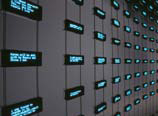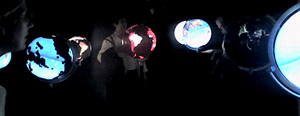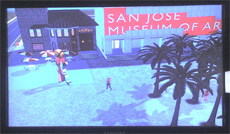August 15, 2006
Edge Conditions

intersectional territory
The Edge Conditions exhibit at the San Jose Museum of Art runs through November 26, 2006 and anyone who didn't catch it as part of ISEA/ZeroOne and who is local to the area, should make the effort to experience it.
Most remarkable sensory engagement was Listening Post by statistician Mark Hansen and media artist Ben Rubin. If you know that Ben, in addition to a background in computer science, works in sound and live performance you can undertand why this piece is so compelling. It is conceptually rich in that the content is pulled live from the internet, but it's the implementation and presentation of the audio, music, and physical layout that combine to envelope, and mesmerize. It's contemplative, yet disturbing in its slickness; seemingly simple in its presentation though it's underlaid by technical sophistication. In sum, it's the well executed balance of aesthetics and computation that is so powerful. The artists' statements are insightful as well.
 Most remarkable cognitive engagement was Ingo Gunther's fascinating WorldProcessor, an installation of illuminated globes visualizing social, political and environmental issues. This catalogue gives some indication of the data represented and how it's mapped to the globes. But it's the ability to walk around each globe and move one to another through the array of illuminated globes in the space that contributes to the impact of the meaning. The relative scale of the globes in relation to your comprehension of the data on a global scale is quite powerful. In this 2001 Shift interview he talks about his process and this ongoing project that began in 1988.
Most remarkable cognitive engagement was Ingo Gunther's fascinating WorldProcessor, an installation of illuminated globes visualizing social, political and environmental issues. This catalogue gives some indication of the data represented and how it's mapped to the globes. But it's the ability to walk around each globe and move one to another through the array of illuminated globes in the space that contributes to the impact of the meaning. The relative scale of the globes in relation to your comprehension of the data on a global scale is quite powerful. In this 2001 Shift interview he talks about his process and this ongoing project that began in 1988.
The above installations, each in a gallery, comprised part I of the exhibit with part II comprised of sculptural and screen-based works. The Edge Conditions curatorial statement noted computers and the internet are simply a set of tools and that the Edge referred to in the exhibit's title is about boundaries and intersectional territories. The following artists re-imagine space in some way, recognizing that the contemporary condition is to be in several places at once.
 SimVeillance uses surveillance camera footage of the plaza outside the museum to generate characters in the game environment; I-5 Passing Lane uses pollution sensors along US I-5 to dynamically playback video scenes from the road; Takuji Kogo's Song for Silicon Valley is a video fabricated from the imagination based on iamgery culled from the internet; Tamiko Thiel's 3d VR installation The Tales of Mariko Horo inverts the Marco Polo story as an exploration of the mythic west; Michael Samyn and Auriea Harvey's MMORPG game Endless Forest, also envisions a fantasy game place that is beatiful and other; C5's Analogous Landscape sculpture and GPS data visualization investigate if mapping from one mountain ascent can be used to navigate another; while Thomson and Craighead's Light from Tomorrow draws attention to the social construction of time, yet the international date line exists because of the interconnectedness of time, space, and place where a day is lost or gained when circumnavigating the globe.
SimVeillance uses surveillance camera footage of the plaza outside the museum to generate characters in the game environment; I-5 Passing Lane uses pollution sensors along US I-5 to dynamically playback video scenes from the road; Takuji Kogo's Song for Silicon Valley is a video fabricated from the imagination based on iamgery culled from the internet; Tamiko Thiel's 3d VR installation The Tales of Mariko Horo inverts the Marco Polo story as an exploration of the mythic west; Michael Samyn and Auriea Harvey's MMORPG game Endless Forest, also envisions a fantasy game place that is beatiful and other; C5's Analogous Landscape sculpture and GPS data visualization investigate if mapping from one mountain ascent can be used to navigate another; while Thomson and Craighead's Light from Tomorrow draws attention to the social construction of time, yet the international date line exists because of the interconnectedness of time, space, and place where a day is lost or gained when circumnavigating the globe.
Posted by michelle at August 15, 2006 01:44 AM
